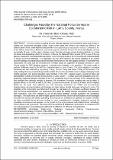| dc.description.abstract | Terrorism remains a cardinal threat to national, regional, and international peace and security. It
violates the fundamental principles of law, order, human rights and freedom and remains an affront to the
Global Charter of the United Nations (UN) and the values and principles enunciated in Africa‟s Constitutive Act
of the African Union (AU). Moreover, it presents a grave and direct threat to the territorial integrity, security
and stability of states. In this regard, effective counter terrorism strategies remain fundamental tools in curbing
the threats and devastating effects of terrorism. In Kenya, the National Police Service (NPS) is one of the key
agencies involved in counterterrorism operations. Given emerging trends of terrorist camps and continued attack
in Kenya by terrorist elements, it is imperative that the NPS improves the overall direction of its counter
terrorism strategy and adopt robust counterterrorism mechanisms in the fight against terrorism. The problem that
necessitated this study was the continued and relentless attack by suspected Al-Shabaab terrorists in Lamu
County despite the NPS adopting numerous counterterrorism strategies in its operations. The study sought to
evaluate challenges faced by the NPS in counterterrorism in Lamu County. The study adopted a conceptual
framework and was informed by Expectancy Theory, Control Theory and Justice Theory of Performance. The
study employed survey research design which entailed the use of ex post facto research design employing mixed
method approach. The target population were members of the NPS, religious leaders, council of elders and
administrators (chiefs and county commissioner) in Lamu County. The study used both probability and nonprobability sampling methods. Members of the NPS comprising NCOs and members of the inspectorate were
first stratified then randomly sampled to generate 189 respondents. Purposive sampling was used to select 12
gazetted officers of the NPS as well as 23 chiefs, 1 county commissioner, 35 council of elders, and 54 religious
leaders for the study. Data collection was both interactive (interviews and FGDs) and non-interactive
(questionnaires, document analysis, photography and observation). A pilot study was carried out in Lamu. The
reliability of the instruments was determined through the calculation of a correlation coefficient between the
first and second administration. The instruments were tested for validity through consultation and discussion
with supervisors. Data were analysed by use of descriptive statistics, through qualitative and quantitative
techniques. The study found out that the fight against terrorism must involve all stakeholders and the strategies
must take into account and address prevailing circumstances and conditions for operation to succeed. Overally,
the study concluded that as terrorism evolves so must counterterrorism strategies, taking into account the
prevailing circumstances and dynamics on the ground such as socio-economic and political factors, technology,
human resource and governance. The study recommended that all stakeholders be involved in counterterrorism
and underlying issues and challenges be addressed for effective and efficient counterterrorism | en_US |
| dc.subject | Al-Shabaab, Antiterrorism, Challenges, Community Policing, Counterterrorism, Counterterrorism Strategy, Terrorism, Police Officer, Terrorist | en_US |

